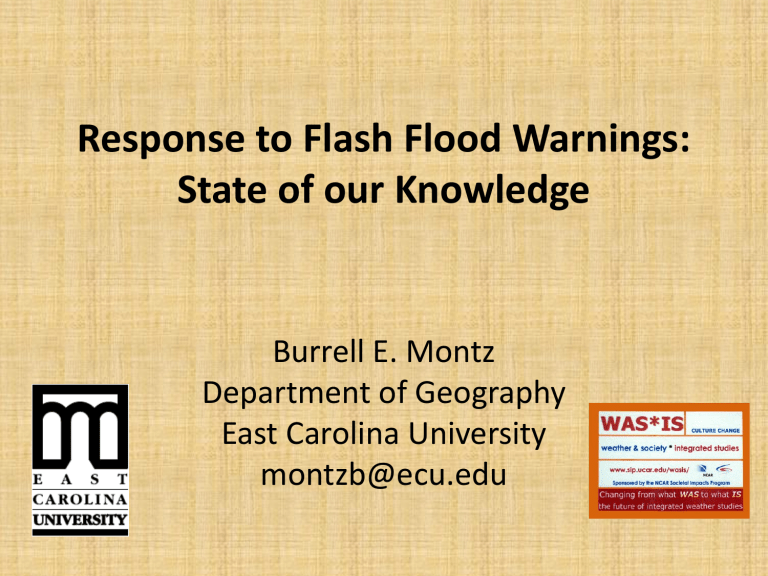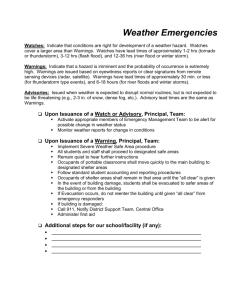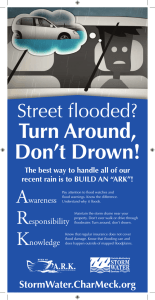Social Science and Societal Impacts of Flash Floods - Burrell Montz, Ph.D., East Carolina University

Response to Flash Flood Warnings:
State of our Knowledge
Burrell E. Montz
Department of Geography
East Carolina University montzb@ecu.edu
• Short fuse events
– Flash floods
– Tornadoes
• Overview of studies
• Summary of findings
• So what...?
Topics
The Problem
There remains, then, the need for a mathematical model of human response to warnings, a model that would mimic all essential characteristics of human response in a setting of a local flood warning system and that would enable one to predict the outcomes of decisionevent pairs.
Krzysztofowicz, R., 1993
Reality
Components of Public Response
Hear
Understand
Believe
Personalize
Decide to act
Respond
What People Say
Gruntfest et al., 2008
What People Do
League, 2008
Actual versus Anticipated Behavior
• Difference between what people say and what they do
• Importance of context and circumstance
• Difficult to document impacts of
– Time
– Memory
– Cognitive dissonance
Tornado Studies: Sources of Information
60
50
20
10
0
40
30
TV Siren Friend/Family Visual Radio
Schmidlin et al., 2009; Schmidlin and King, 1997; Balluz et al., 2000
Actions and Reasons:
35% took shelter
• Positive actions correlated with
– Perceived danger
– Presence of children
– High school education
– Hearing warning
– Having a basement
– Being married
• Negative actions correlated with
– Previous damage
– Less education
– God’s will
– Lack of access to shelter
– Limited mobility
• No correlation
– Age, gender, race
– Lead time
– Owning NWR
– Family size
– Previous experience
NWS Service Assessments
• Super Tuesday 2008
Tornadoes
– 57 dead
– 18 (32%) heard some warnings
– 11 (61%) heeded warnings
– 8 (44%) sought shelter
– 6 (33%) did not
• Mothers’ Day 2008
Tornadoes
– 21 dead
– 11 (52%) knew of warning
– 10 (47.6%) tried to take shelter
________________________
– 14 groups interviewed
– 6 (42.8%) heard official warning
– 6 heard from family or friends
– 4 (28.5%) sought shelter
– 6 tried but it “came too fast”
Flood Fatalities
70
60
50
40
90
80
10
0
30
20
Total Fatalities
Flood
Flash Flood
2005 2006 2007
Source: League, 2009, http://www.geo.txstate.edu/lovell/IFFL/research.html
Vehicle Deaths
100
90
80
70
60
50
40
30
20
10
0
2005 2006 2007 Total % Vehicle
Fatalities
Source: League, 2009, http://www.geo.txstate.edu/lovell/IFFL/research.html
% Vehicle
Flood
Flash Flood
Gender Breakdown
*
40
30
20
10
60
50
Flood Male
Flood Female
Flash Flood Male
Flash Flood Female
0
2005 2006 2007 Total
Source: League, 2009, http://www.geo.txstate.edu/lovell/IFFL/research.html
* Where reported
So what about warnings?
League, 2009
But...
There is a difference between
•Intentional Drivers
•Situational Drivers
False Alarms, Near Misses, and Response
• What we know
– Very different definitions of false alarms
• NWS vs public
– Perceptions of accuracy vary
• NWS vs public
– Cry wolf or warning fatigue or neither
– Influence of event type
– We don’t know enough
Barnes et al., 2007
There is no ONE public
• Different languages
• Different understandings
• Different situations
• Different capabilities
• Different needs
And...
Vulnerability Factors
Socio-economic and demographic attributes
Social structures
Infrastructure
Attitudinal, psychological, and knowledge factors
Warning systems
Public policy/risk management
Spatial and temporal aspects of event
Indicators
Age, gender, income, profession, family situation
Cohesion of community; social networks
Building quality and types
Experience, risk perception, views of nature, press coverage
Communication channels and relevancy
System of actors; decision-making process
Time of day; location; local knowledge
Long way to go...
Conclusion
• NWS mission: Protect life and property
• NWS warnings are only the beginning of meeting this mission
• Warnings move through various paths to the public
• Warnings are received and understood differently
• Collaborative effort required to get positive, protective responses
• Social science research required to understand why people respond the way they do under what circumstances
Thank you
Any questions you’d like to wade through?
http://blogs.davenportlibrary.com/sc/wp-content/uploads/2008/04/no-wading.jpg







